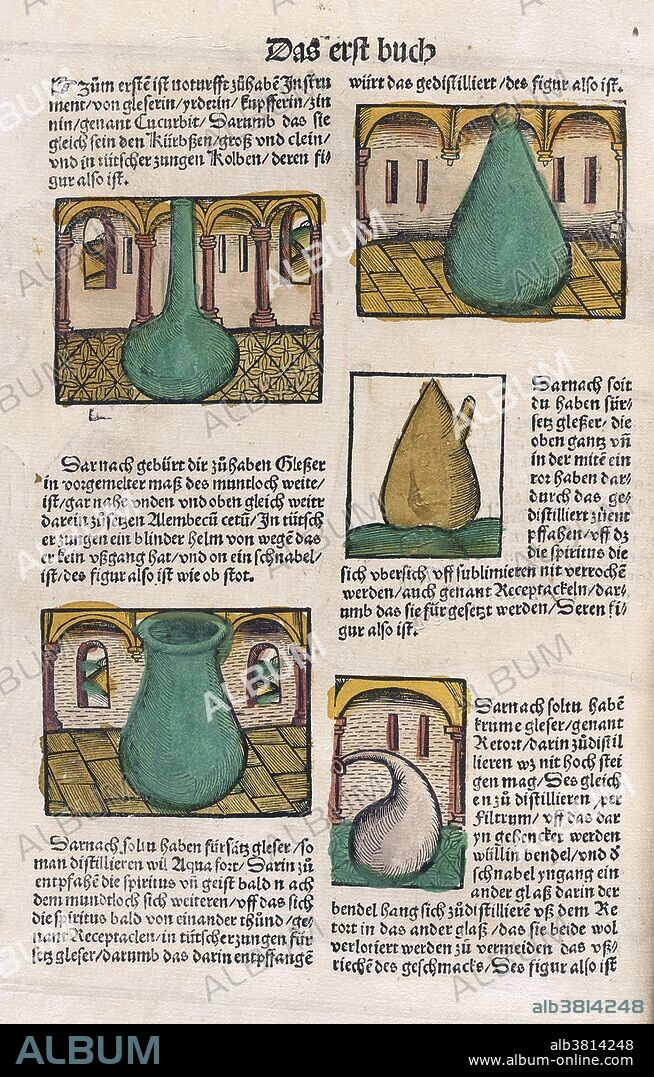alb3814248
Distillation and Recirculation Vessels, 1512

|
Add to another lightbox |
|
Add to another lightbox |



Title:
Distillation and Recirculation Vessels, 1512
Caption:
Various types of distillation and recirculation vessels: on the left side, top, a simple bulbous ampulla (bottle or flask), which stores distilled waters; and bottom, a large bulbous flask, possibly made of glass. On the right side, top, philosopher's egg made of glass, which can withstand the fire's heat; center, a closed receiver; and bottom, a gourd-shaped retort. Brunschwig's Liber de arte distillandi simplicia et composita (Little Book of Distillation) was one of the earliest books ever written concerning the subjects of chemistry and pharmacology. Printed in Strasbourg in 1512, it is a practical manual on chemical, alchemical, and distillation devices and techniques used to manufacture drug therapies. It includes instructions on how to distill aqua vitae, potable gold, artificial and natural balsams and how to use distillates to treat illnesses in surgical cases. The last of the 16th century herbals, this book is widely regarded to be an important link between the Middle Ages and modern times. Hieronymus Brunschwig (1450 - 1512), was a German physician, surgeon, chemist, and pharmacologist. He was notable for his early work on chemical techniques, as well as his methods of treatment of gunshot wounds. He died in 1512 at the age of 61 or 62.
Credit:
Album / NLM/Science Source
Releases:
Model: No - Property: No
Rights questions?
Rights questions?
Image size:
2700 x 4226 px | 32.6 MB
Print size:
22.9 x 35.8 cm | 9.0 x 14.1 in (300 dpi)
Keywords:
1512 • 16 16TH XVI XVITH SIXTEENTH CENTURY • 16TH CENTURY • ALCHEMICAL • ALCHEMY • ALCHEMY, ALCHEMIST • APPARATUS • ART • ARTWORK • BOTTLE • BRAUNSCHWEIG • BRUNSCHWIG • BRUNSCHWYGK • BULBOUS AMPULLA • CHEMISTRY • CLOSED RECEIVER • DEVICE • DISTILL • DISTILLATE • DISTILLATION BOOK • DISTILLATION • DISTILLERY • DISTILLING APPARATUS • DISTILLING DEVICE • DISTILLING EQUIPMENT • DRAWING • EQUIPMENT • FLASK • GOURD-SHAPED RETORT • HIER BRUNSCHWYGK • HIERONYMUS BRAUNSCHWEIG • HIERONYMUS BRUNSCHWIG • HISTORIC • HISTORICAL • HISTORY • ILLUSTRATION • LIBER DE ARTE DISTILLANDI SIMPLICIA ET COMPOSITA • LIBER DE ARTE DISTILLANDI • LITTLE BOOK OF DISTILLATION • PHILOSOPHER'S EGG • PURIFICATION • RECIRCULATION • REFINING • RETORT • SCIENCE • VESSEL STILL • WOODBLOCK • WOODCUT • XYLOGRAPHY
 Pinterest
Pinterest Twitter
Twitter Facebook
Facebook Copy link
Copy link Email
Email
